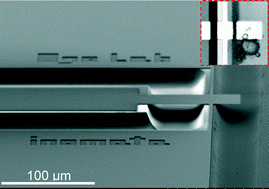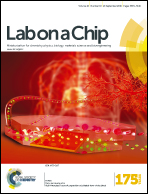Highly sensitive thermometer using a vacuum-packed Si resonator in a microfluidic chip for the thermal measurement of single cells
Abstract
A highly sensitive thermometer system for a living cell is proposed, fabricated, and evaluated. The system possesses a resonant thermal sensor surrounded by vacuum in a microfluidic chip. The measurement principle relies on resonant frequency tracking of the resonator in temperature variations due to the heat from a sample cell; the heat is conducted from the sample cell in the microfluidic channel via a heat guide connecting the resonator to a sample stage. This configuration can reduce heat loss from the resonator to the surroundings and damping in water. Two types of resonators are prepared, i.e., a cantilevered resonator and a double-supported resonator. The resonator sizes as a sensor are 30 × 50 × 1.5 μm in the cantilevered resonator, 30 × 75 × 0.40 μm in the double-supported one, respectively. The temperature and thermal resolutions of 79 μK and 1.90 nW, respectively, are achieved using the double-supported resonator. Two types of heat emissions from single brown fat cells are detected; one is continuous heat generation in the presence of chemical stimulation by a norepinephrine solution, and the other is pulsed without any stimulation.


 Please wait while we load your content...
Please wait while we load your content...